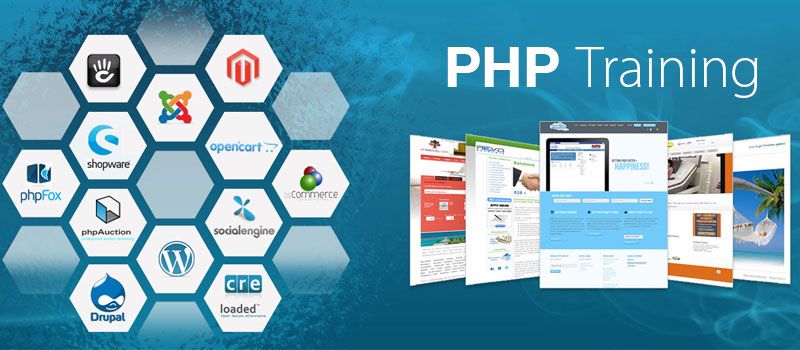
PHP Training Institutes in Tirupati – PHP Course Overview
PHP is a widely-used general-purpose scripting language that is especially suited for Web development and can be embedded into HTML.
- PHP can generate dynamic page content
- php can create, open, read, write, and close files on the server
- It can collect form data
- It can send and receive cookies
- It can add, delete, modify data in your database
- PHP can restrict users to access some pages on your website
- PHP can encrypt data
With PHP you are not limited to output HTML. You can output images, PDF files, and even Flash movies.
PHP Training Course Prerequisite
- HTML
- CSS
- Javascript
Objectives of the Course
- PHP runs on different platforms (Windows, Linux, Unix, Mac OS X, etc.)
- PHP is compatible with almost all servers used today (Apache, IIS, etc.)
- PHP has support for a wide range of databases
- PHP is free. Download it from the official PHP resource: www.php.net
- PHP is easy to learn and runs efficiently on the server side
PHP Training Course Duration
- 45 Working days, daily 1.30 hours
Contact Form
PHP Training Course Overview
An Introduction to PHP
- History of PHP
- Versions and Differences between them
- Practicality
- Power
- Installation and configuring Apache and PHP
PHP Basics
Default Syntax
- Styles of PHP Tags
- Comments in PHP
- Output functions in PHP
- Datatypes in PHP
- Configuration Settings
- Error Types
Variables in PHP
- Variable Declarations
- Variable Scope
- PHP’s Superglobal Variables
- Variable Variables
Constants in PHP
- Magic Constants
- Standard Pre-defined Constants
- Core Pre-defined Languages
- User-defined Constants
Control Structures
- Execution Control Statements
- Conditional Statements
- Looping Statements with Real-time Examples
Functions
- Creating Functions
- Passing Arguments by Value and Reference
- Recursive Functions
Arrays
- What is an Array?
- How to create an Array
- Traversing Arrays
- Array Functions
Include Functions
- Include, Include_once
- Require, Require_once
Regular Expressions
- Validating text boxes,emails,phone number,etc
- Creating custom regular expressions
Object-Oriented Programming in PHP
- Classes, Objects, Fields, Properties, _set(), Constants, Methods
- Encapsulation
- Inheritance and types
- Polymorphism
- Constructor and Destructor
- Static Class Members, Instance of Keyword, Helper Functions
- Object Cloning and Copy
- Reflections
PHP with MySQL
- What is MySQL
- Integration with MySQL
- MySQL functions
- Gmail Data Grid options
- SQL Injection
- Uploading and downloading images in Database
- Registration and Login forms with validations
- Pagging, Sorting,…..
Strings and Regular Expressions
- Declarations styles of String Variables
- Heredoc style
- String Functions
- Regular Expression Stntax(POSIX)
- PHP’s Regular Expression Functions(POSIX Extended)
Working with the Files and Operating System
- File Functions
- Open, Create and Delete files
- Create Directories and Manipulate them
- Information about Hard Disk
- Directory Functions
- Calculating File, Directory and Disk Sizes
Error and Exception Handling
- Error Logging
- Configuration Directives
- PHP’s Exception Class
- Throw New Exception
- Custom Exceptions
Date and Time Functions
Authentication
- HTTP Authentication
- PHP Authentication
- Authentication Methodologies
Cookies
- Why Cookies
- Types of Cookies
- How to Create and Access Cookies
Sessions
- Session Variables
- Creating and Destroying a Session
- Retrieving and Setting the Session ID
- Encoding and Decoding Session Data
- Auto-Login
- Recently Viewed Document Index
Web Services
- Why Web Services
- RSS Syntax
- SOAP
- How to Access Web Services
XML Integration
- What is XML
- Create a XML file from PHP with Database records
- Reading Information from XML File
MySQL Concepts
- Introduction
- Storage Engines
- Functions
- Operators
- Constraints
- DDL commands
- DML Commands
- DCL Command
- TCL Commands
- Views
- Joins
- Cursors
- Indexing
- Stored Procedures
- Mysql with PHP Programming
- Mysql with Sqlserver(Optional)
SPECIAL DELIVERY
- Protocols
- HTTP Headers and types
- Sending Mails using PHP
- Email with Attachment
- File Uploading and Downloading using Headers
- Implementing Chating Applications using PHP
- and Ajax
- SMS Gateways and sending SMS to Mobiles
- Payments gateways and How to Integrate them
With Complete
- MVC Architecture
- DRUPAL
- JOOMLA
- Word Press
- AJAX
- CSS
- JQUERY (Introduction and few plugins only)



